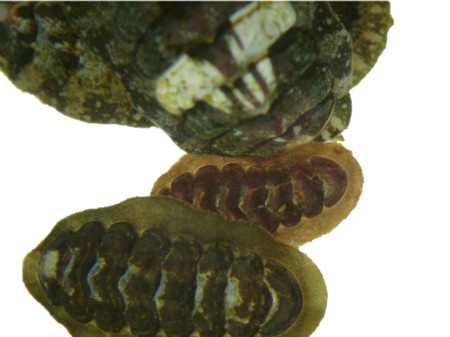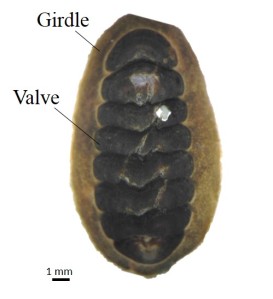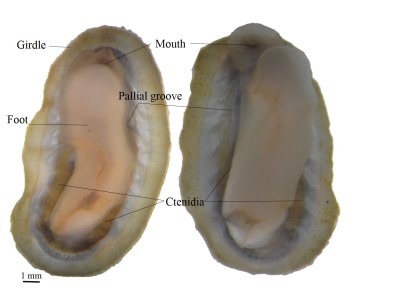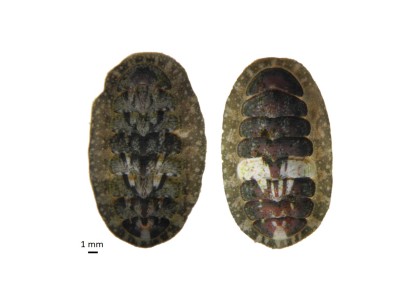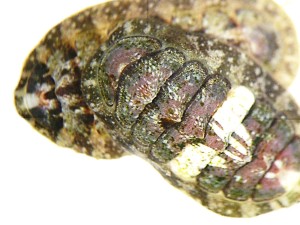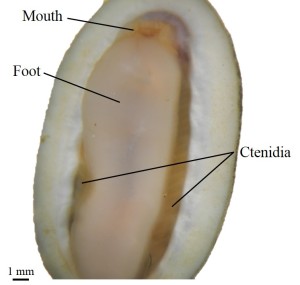I recently collected several small brown chitons (Mollusca, Polyplacophora) from a site in Northern Washington. I was trying to find a species that has only been reported from this region, and that has a few interesting things going on with its reproduction. While most chitons are gonochoric (=separate sexes) and broadcast spawn, several are hermaphroditic, capable of self-fertilization, and brood their young.
Cyanoplax fernaldi is one such selfing chiton and occurs in a relatively narrow geographic range, with individuals found from San Juan Island to Tacoma, WA (Eernisse 1986). So I was really excited when I came across a few chitons that fit the general description of the Cyanoplax genus (being small and mostly brown) on a recent trip to the Northwest.
The question, however, was whether I had actually collected C. fernaldi or one of the other species of closely related Cyanoplax spp. Because confidently identifying them in the field without a microscope proved difficult, I decided to bring back a few of each putative species to the lab for closer examination.
From reading the species description and key of C. fernaldi in Eernisse (1986) there are several characteristics that will be very useful in its identification:
Valves often appear worn. The girdle (tissue surrounding the valves) is dark and girdle ornamentation is simple.
That fits the description for several of the chitons that I collected, including the one shown above.
Now we look at the ventral surface for ctenidia (gills), there should be 8-17 per side, extending 60 – 75% of foot length.
That also looks correct for these individuals. Eernisse also notes that you often seen brooded larvae in the pallial groove of C. fernaldi, but I don’t see any here.
We can see how this compares to the other individuals I collected.
These two have very colorful valves and girdles, and they differ from each other a lot. I collected all of these chitons from the same spot (they were right next to each other), but seeing this much phenotypic variation makes me think of another species that Eernisse has documented in Northern Washington (1986), Cyanoplax dentiens, a very common species with a wide geographic range (Baja to Alaska).
C. dentiens is a gonochoric, broadcast spawning species that shows tremendous within population phenotypic variation. In fact, Eernisse (1986) states that one way to rule out the collection of C. dentiens is if all the individuals collected share a common phenotype. Eernisse also cautions that due to its variable phenotype C. dentiens is easily confused with other species (Eernisse 2007, Eernisse et al 2007).
Characteristics of C. dentiens from the Light and Smith Manual indicate that the valves are rarely eroded, their coloration is complex and highly variable, and there are often blue or green streaks on the valves. Furthermore, there is often a pattern of alternating light and dark bands on the girdle. Those characteristics describe these chitons well.
Here’s another image showing the “cyan” flecks in their valves.
Next, let’s look at the ventral surface and ctenidia. Ctenidia in C. dentiens extend 95% of foot length.
It’s a little hard to see in this photo , but the ctenidia extend almost the entire length of the foot. There were no brooded larvae for these multi-colored individuals either.
From the images and observations presented above, I am reasonably confident that the individuals I collected are C. fernaldi and C. dentiens.
I find several features of Cyanoplax fernaldi interesting. First, the reduced number of ctenidia in C. fernaldi compared with that of C. dentiens is notable. Is this possibly due to a tradeoff between brood space and respiration? If this is the case, other brooding chitons might be expected to have gills that routinely occupy less of the pallial groove than non-brooding species. This may be so, as two other brooding species C. thomasii (gonochoric) and C. caverna (hermaphroditic) have ctenidia that extend over 90% and 80% of the length of the foot, respectively, while non-brooding species (e.g., C. hartwegii) appear to have gills that extend the entire length of the foot.
Second, the worn appearance of the valves in C. fernaldi could be due to abrasions that occur when they cram themselves into the nooks and crannies of their rocky habitat. However, I collected C. dentiens from the same site and saw individuals from both species wedged into tight places. C. dentiens does not show any of the same wear. This suggests that the difference in valve erosion might be due to compositional differences in the shell itself. I wonder if as a species known to self, reduced valve strength is a consequence of inbreeding depression that has yet to be purged?

Interesting things come in small packages! Cyanoplax spp. rarely exceed 3 cm. image credit: SA Caplins
References
Eernisse DJ (1986). The genus Lepidochitona GRAY, 1821 (Mollusca: Polyplacophora) in the Northeastern Pacific Ocean (Oregonian and Californian provinces). Zoologische Verhandelingen 228: 3-52.
Eernisse DJ (2007). Chitons. Pp. 127-133, in: Encyclopedia of Tidepools and Rocky Shores. M. W. Denny and S. D. Gaines (Eds.) University of California Press, Berkeley, California.
Eernisse DJ, Clark RN, and Draeger A (2007). Polyplacophora. Pp. 701-713, in: Light and Smith Manual: Intertidal Invertebrates from Central California to Oregon, 4th Ed. J. T. Carlton (Ed.). University of California Press, Berkeley, California.
